Nolina, yucca, and cypress add xeric structure in lush Austin garden
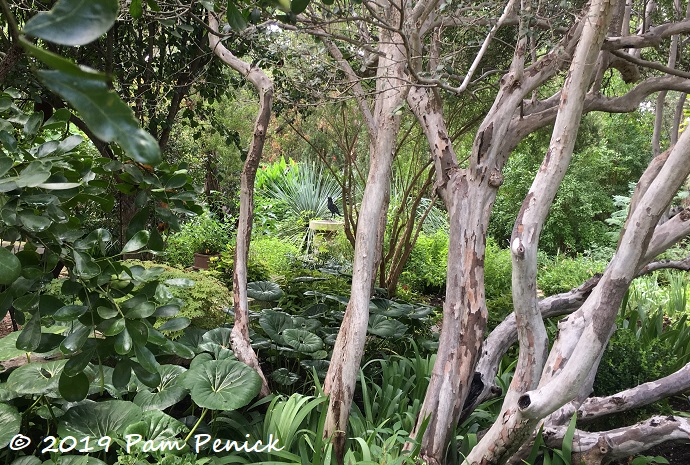
Have you ever seen a glorious spring garden fade by late summer into a semi-dormant hot mess? That’s what happens in Texas when you don’t include structural plants and hardscape to give your garden shape and interest in hotter, drier seasons.
Landscape architect Jackson Broussard (formerly of Sprout, now principal at JPB Design Studio) says a lack of structure challenged this Rollingwood garden in West Austin when he was hired to redesign it. Aside from an enormous and beautiful Texas persimmon, whose sinuous, silver-gray trunks support a canopy of gray-green leaves, the garden was a mass of spring-blooming perennials and annuals and then…nothing.
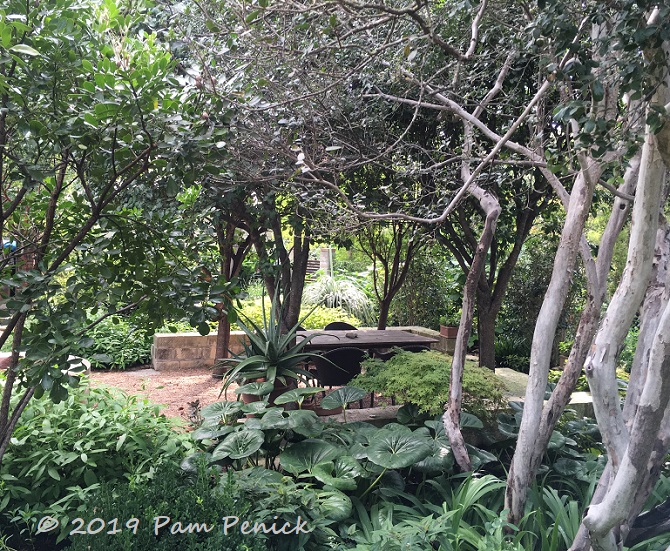
One of the first things he did was carve out a central dining patio defined by low seat-walls and shaded by a living arbor of Bradford pears espaliered onto an arched rebar frame.
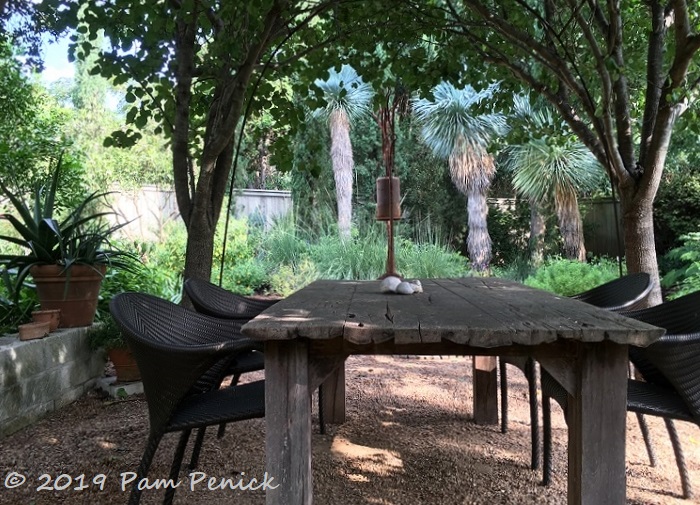
Bradford pears are often derided for their weak branching structure, but Jackson likes to train them into deciduous arbors. No doubt the rebar structure gives them additional support. (I wonder if our native plum tree, Prunus mexicana, could be grown to similar effect?) The owners of this garden, Margie and Al McClurg, enjoy sitting out here every day. I love the view through the pear arbor of a trio of shaggy-headed, blue Yucca rostrata.
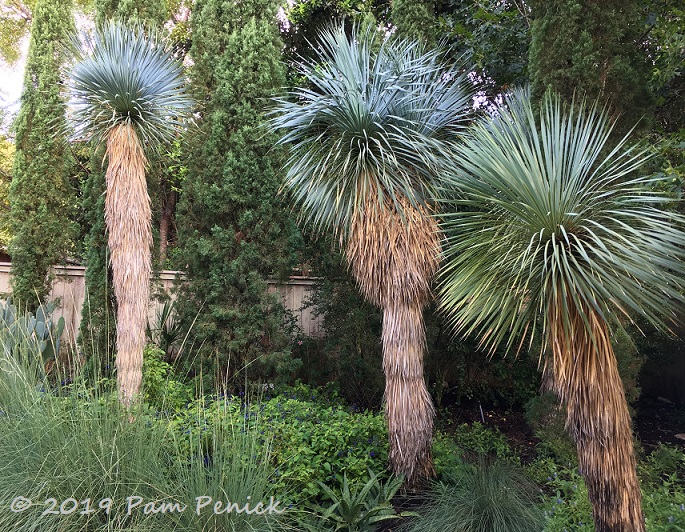
Jackson said the yuccas were already present when he began reorganizing the garden, but they were growing downhill of the house in a seldom-seen area. He moved them here to create bones for this garden and provide a focal point through the arbor. (They are easily moved, he said, but very top-heavy and need to be anchored for a year or two after moving them.)
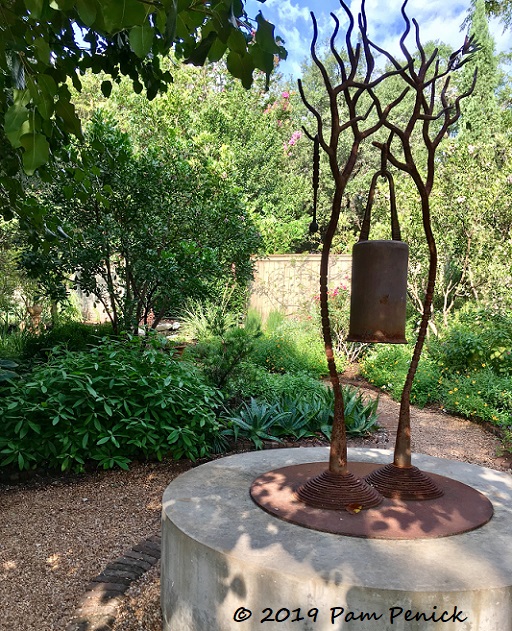
He also added gravel paths throughout the garden to lead the eye through the dense plantings and provide an invitation to explore. Between the pear arbor and the yuccas, the path widens into a circle, and at the center a round concrete plinth displays a twiggy steel sculpture. Originally a large olive jar was displayed here, until a hackberry fell and smashed it.
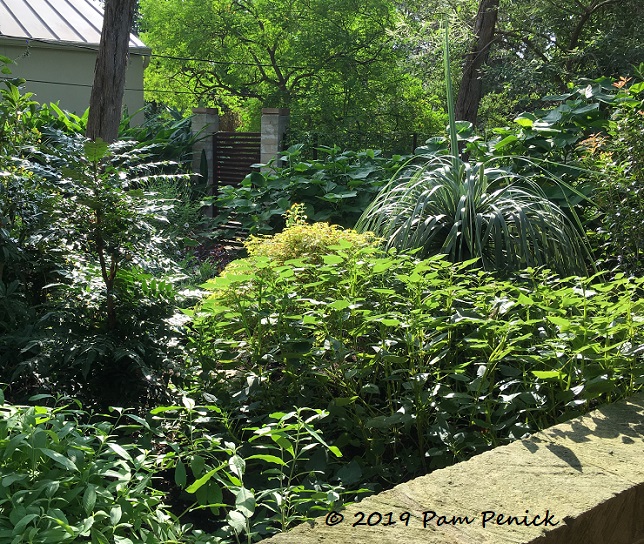
Now a mix of shrubs and xeric evergreens like blue nolina (Nolina nelsonii) add year-round structure to the garden so that there’s something interesting to look at no matter the season.
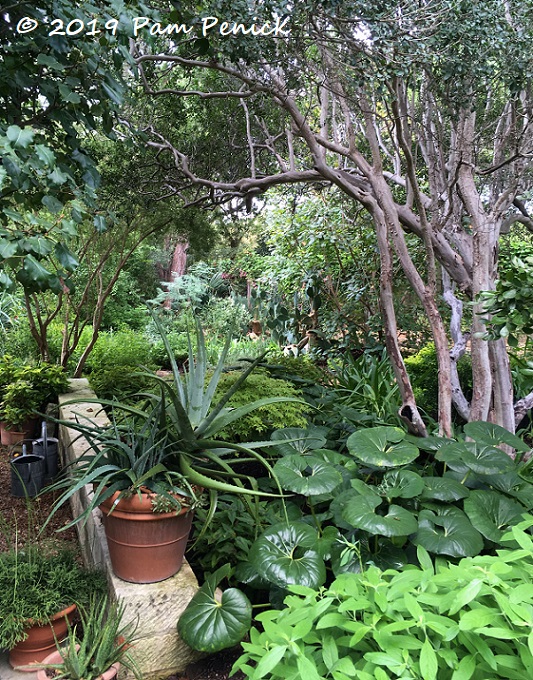
Below the Texas persimmon grow giant ligularia and other shade lovers. A low limestone wall along each side of the dining patio adds extra seating and structure.
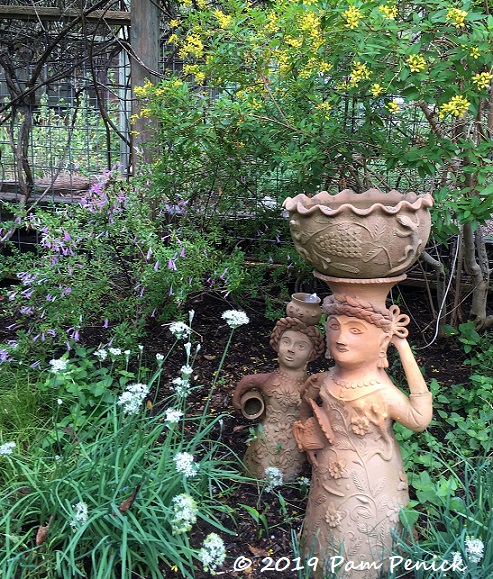
Garlic chives, Mexican oregano, and golden thryallis bloom in a sunny patch alongside a fenced vegetable garden.
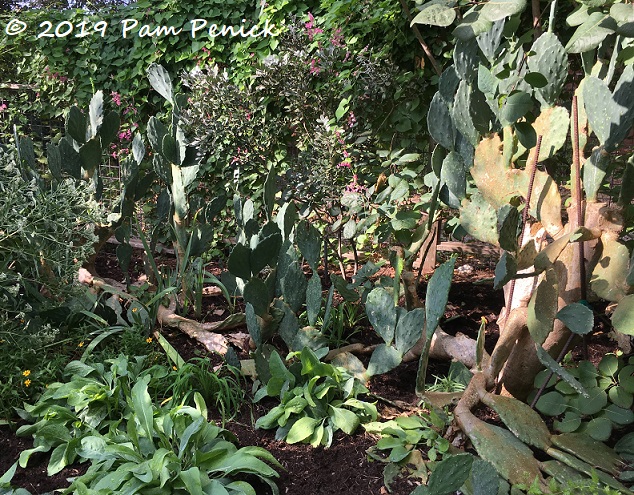
I have this same wavy-leaf spineless prickly pear in my garden, and boy, does it like to travel. Check it out: the heavy pads eventually fall over, and wherever they land, they root. In this way, the plant “walks” across the garden. It can spread into quite the cactus thicket unless you’re diligent about pruning it. Or you can let it go where it wants, as seen here — a Southwestern hedge.
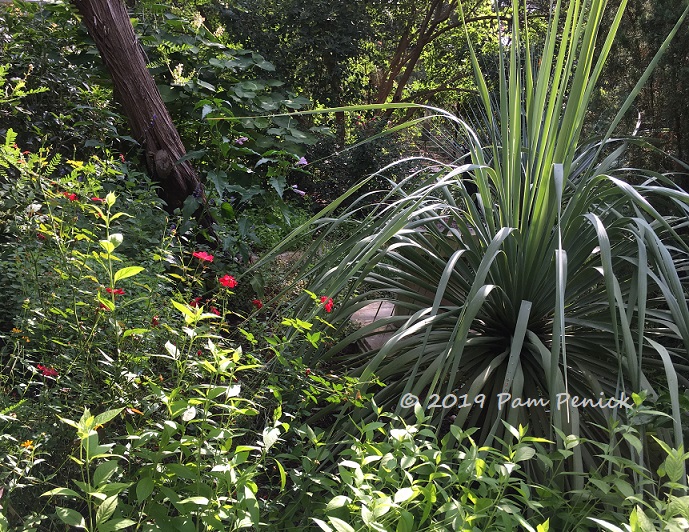
Red roses and blue nolina (Nolina nelsonii), a pretty combo
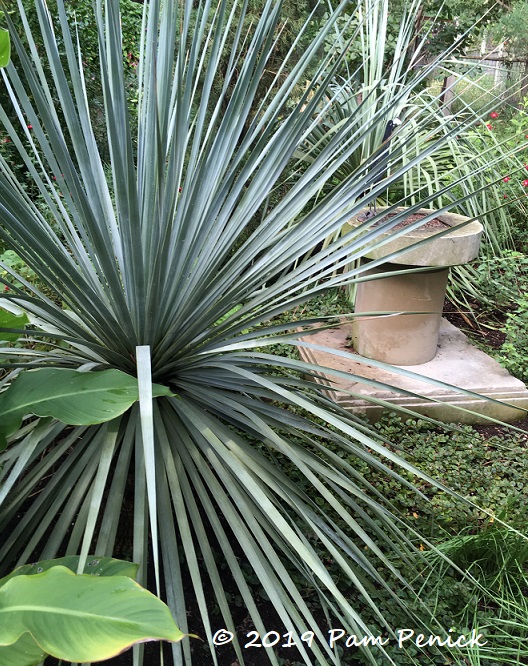
Jackson added a lot of blue nolina for structure and foliage color. I absolutely adore this plant, having first seen it at Barton Springs Nursery growing tall in a shady area. I brought one home and planted it beneath a cluster of live oaks, where it’s doing great. But it is a slooooow grower. Buy a big one, or be prepared to wait a decade for the impact of this size.

Jackson added vertical punctuation marks by planting Italian cypress here and there. Italian cypress tends to get infested with spider mites in central Texas, and so I prefer better-adapted (and smaller-scale) native cultivars like ‘Will Fleming’ yaupon. Either way, a few strategically clustered columnar trees provide an interesting contrast to shrubby, rounded, and sprawling plants.
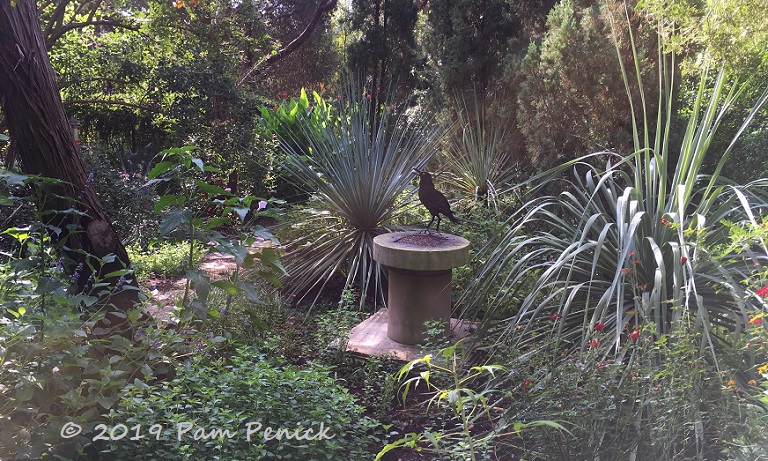
In a lushly planted area directly opposite the dining patio, a triangle of blue nolinas attracts the eye to my favorite art piece in the garden: a metal raven clutching a glass bead in its beak, perched on a toadstool-shaped plinth. Jackson said the raven was already in the garden when he started redesigning. Elevating it and placing it on axis with the pear arbor, surrounded by the strappy nolinas, turned it into a major focal point. Sometimes it’s the simplest tricks that transform an ordinary piece of garden art into a showpiece.
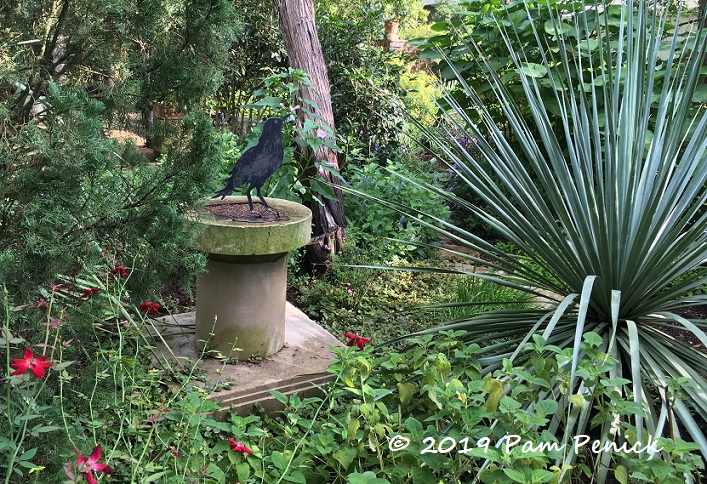
The raven is now a focal point from various parts of the garden.
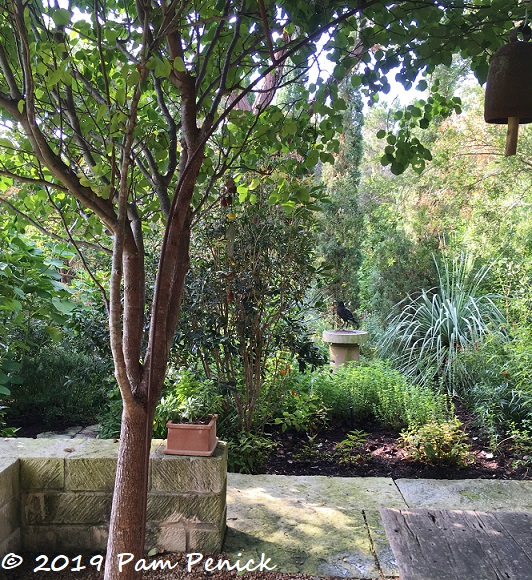
From the dining patio, it draws the eye across the path into the larger garden.
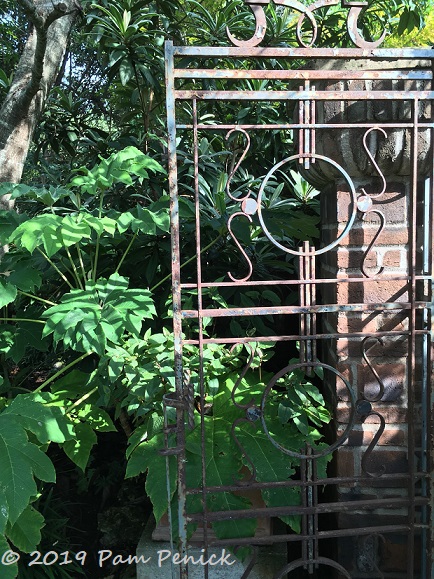
A pretty wrought-iron gate leads to a walled courtyard enclosing a swimming pool.
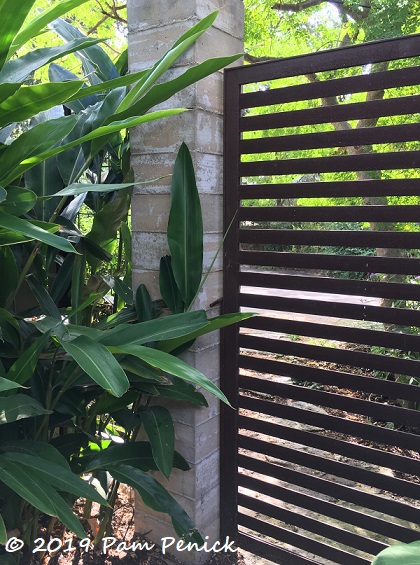
At another entrance, Jackson fabricated this contemporary gate out of rusty steel slats, with a gatepost of board-formed concrete.
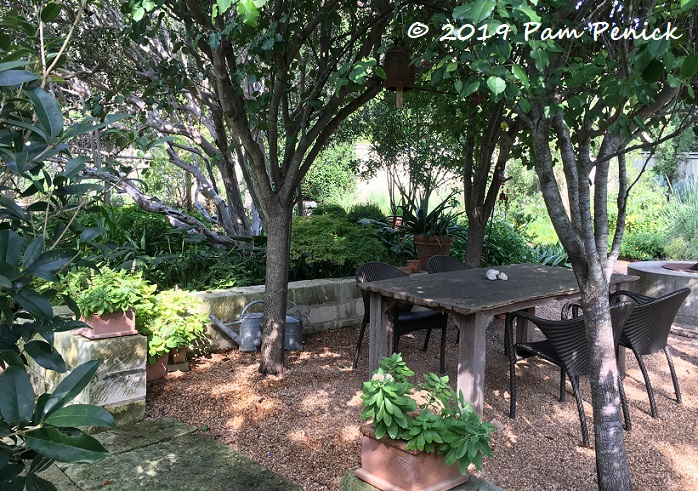
I’ve been fortunate to visit the McClurg garden multiple times in spring (including at Austin Garden Bloggers Fling), when poppies and iris are in bloom. But I’d never seen it in summer, much less at the end of a brutal several months of triple-digit temps and no rain. Thanks to the strong bones provided by structural plants, seat-walls, an arbor-shaded patio, elevated art, and paths, the garden has no trouble looking great even when spring flowers are a distant memory.
My thanks to Jackson and Margie McClurg for sharing the garden with me again!
__________________________
Digging Deeper
Come learn about gardening and design at Garden Spark! I organize in-person talks by inspiring designers, landscape architects, authors, and gardeners a few times a year in Austin. These are limited-attendance events that sell out quickly, so join the Garden Spark email list to be notified in advance; simply click this link and ask to be added. Season 8 kicks off in fall 2024. Stay tuned for more info!
All material © 2025 by Pam Penick for Digging. Unauthorized reproduction prohibited.


That’s one beautiful year-round garden!
It’s a lovely design, and I’m sure they do enjoy it year-round.
Amazing garden and talented designer! That giant ligularia is on my plant envy list. I just can’t seem to get it to survive.
I’m trying it this year in my own garden. It’s been a difficult summer to get it established. I have to water it 3 times a week, but I’m hopeful once it’s established (in deep shade) it will require watering only once a week. We’ll see!
I’ve admired this garden every time I’ve seen it on Central Texas Gardener (CTG) and in print magazines. And I’ve enjoyed the CTG segment I’ve seen of Jackson on his own landscape. Just a comment in general of all landscape tours (virtual and physical) and destination, educational gardens, such as the Lady Bird Johnson Wildflower Center: It would be great if, besides the beautiful garden seen, information on water requirements to keep the garden looking “garden worthy” would also be provided. I would think people know how much watering they are doing to supplement natural rainfall? And especially if certain landscapes are considered more water-wise, give us some idea of what that means in practical terms–is the garden watered 1 inch a week or more or less when lack of rainfall and temps require watering? I know the amount of water depends on variables such as the soil type, soil covering, sun/shade, etc., but trying to get an idea if I can get a lush landscape of natives/adapted plants by watering once every 2 weeks (instead of once/week currently for St. Augustine lawn) during these Austin summer/fall scorchers.
Those are good but difficult questions, Beverly. As you already know, watering info is very dependent on site conditions: how much shade/sun, type of soil, are the plants established vs. newly planted, how much rainfall, how hot it’s been, whether at the top or bottom of a hill, etc. On top of that, not every homeowner knows exactly how much water they use, especially if they “set it and forget it” with their irrigation system or use a maintenance service (more typical with high-end designed gardens), and not everyone wants to divulge for public record how much water they use unless it’s very low.
Like you I’m curious, and so I usually ask in a roundabout way, although I never want to seem as if I’m holding a watering inquisition. Honestly, to get the detailed info you’re hoping for would require a more direct line of questioning than I’m comfortable with when I’m a guest in someone’s garden. In general I’d say that the lusher the garden (especially if you see plants with large leaves, excluding agaves), the more water it’s getting. Or maybe the gardener hand-waters the thirstier plants as needed but in general the garden gets watered once a week in summer.
You can absolutely have a garden that can get by on watering once every two weeks (once it’s established, and perhaps with supplemental water during very hot and dry periods, like now), but it will look considerably less lush in summer than the garden pictured here. I’m thinking of tough natives like Salvia greggii, agaves, Mexican feathergrass, Texas mountain laurel, evergreen sumac, Texas nolina, cenizo, etc. These plants are beautiful too! Water conservation is an important goal when making a garden in hotter, drier climate. But there are other benefits too to having a garden vs. lawn: habitat for wildlife and pollinators that rely on residential gardens more than ever, a sense of place, seasonal beauty, and a connection with nature.
Here in the PNW we don’t have gardens that devolve into hot messes in the summer, but they can turn into crispy messes because of the lack of rain. I think that’s one reason why gardeners like Loree have used so many traditional Texas, or Southwest plants in their gardens. Thanks for showcasing such an interesting garden with great art. The crow reminds me very much of the work of an artist who exhibits every year at the Northwest Flower and Garden Festival, Abraxas Crow. Peter showed some of his work in a post, here: http://outlawgarden.blogspot.com/2018/02/the-northwest-flower-and-garden.html
I enjoyed seeing the art pieces on Peter’s blog, so thanks for linking to that, Alison. And yes, every region has its challenges!